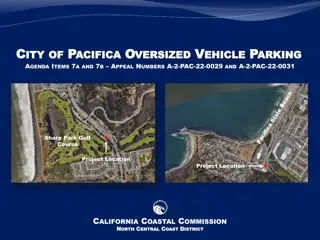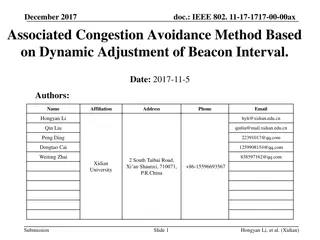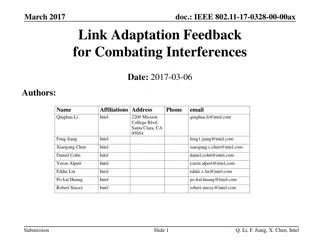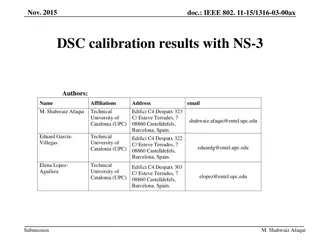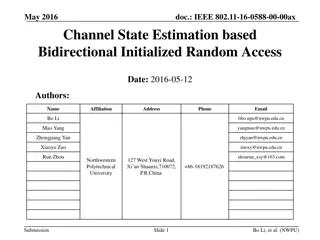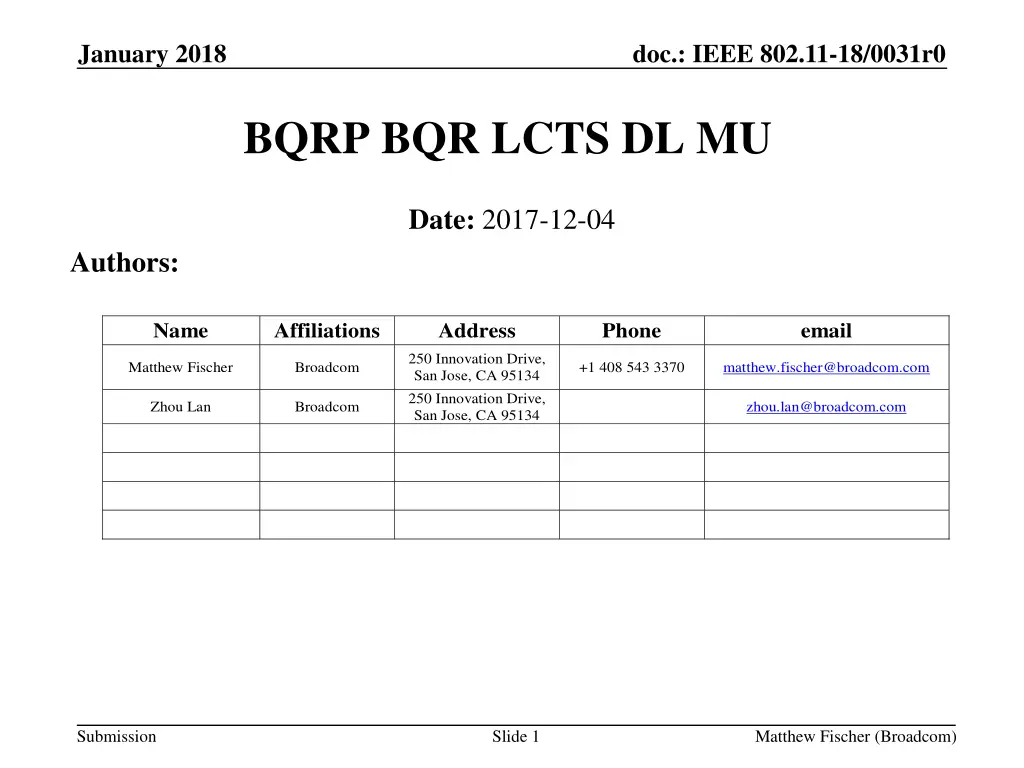
January 2018 IEEE 802.11-18/0031r0 Document Updates
Explore the latest updates in the January 2018 IEEE 802.11-18/0031r0 document discussing topics such as BQR sequence, ER implications, MU-RTS/CTS operation enhancements, and more.
Download Presentation

Please find below an Image/Link to download the presentation.
The content on the website is provided AS IS for your information and personal use only. It may not be sold, licensed, or shared on other websites without obtaining consent from the author. If you encounter any issues during the download, it is possible that the publisher has removed the file from their server.
You are allowed to download the files provided on this website for personal or commercial use, subject to the condition that they are used lawfully. All files are the property of their respective owners.
The content on the website is provided AS IS for your information and personal use only. It may not be sold, licensed, or shared on other websites without obtaining consent from the author.
E N D
Presentation Transcript
January 2018 doc.: IEEE 802.11-18/0031r0 BQRP BQR LCTS DL MU Date: 2017-12-04 Authors: Name Affiliations Address Phone email 250 Innovation Drive, San Jose, CA 95134 250 Innovation Drive, San Jose, CA 95134 Matthew Fischer Broadcom +1 408 543 3370 matthew.fischer@broadcom.com Zhou Lan Broadcom zhou.lan@broadcom.com Submission Slide 1 Matthew Fischer (Broadcom)
January 2018 doc.: IEEE 802.11-18/0031r0 Abstract To improve efficiency Establish the sequence: BQRP (a Trigger for BQR, or generally, any Trigger) HE TB BQR (i.e. elicited HE TB PPDU response) Non-HT CTS and/or non-HT DUP CTS (TX by non-AP STA) Optional overlapping CTS2SELF transmitted by the AP DL MU PPDU BA Insertion of a command bit within the Trigger New POLL-CTS subfield which is used to elicit non-HT CTS SIFS after the elicited HE TB PPDU Also consider ER implications Submission Slide 2 Matthew Fischer (Broadcom)
January 2018 doc.: IEEE 802.11-18/0031r0 CID 13827 Revise Tgax editor to include L- CTS transmission option within BQR sequence by implementing the changes shown in 11-18/0056r0 "A STA may send BQRs to an AP to assist DL MU and UL MU resource allocation in an efficient way." Improve the text, e.g., "A non-AP HE STA may send BQRs to the AP with which it is associated to assist DL MU and UL MU resource allocation in an efficient way." 13827Yasuhik 243.27 27.5.2 o Inoue This text is ambiguous compared to the other sentence in this subclause. Submission Slide 3 Matthew Fischer (Broadcom)
January 2018 doc.: IEEE 802.11-18/0031r0 CID 14328 Revise Tgax editor to include L- CTS transmission option within trigger sequence by implementing the changes shown in 11-18/0056r0 14328Zhou 226.3027.2.5.2MU-RTS procedure doesn't provide sufficient support for range extension mode operation. A near edge STA after receive MU-RTS frame from AP may not be able to succesfully deliever CTS back to AP. As a consequence AP cannot use ER SU PPDU for DL transmission to the near edge STA. Need to enhance the MU- RTS/CTS operation to enable ER SU PPDU transmission. as in the comment Lan Submission Slide 4 Matthew Fischer (Broadcom)
January 2018 doc.: IEEE 802.11-18/0031r0 CID 12593 Revise Tgax editor to include L- CTS transmission option within ER sequence by implementing the changes shown in 11-18/0056r0 12593Mark 324.48 Delete Subclause 27.16.5 ER beacons don't work for the same reason they didn't work with STBC (and got obsoleted): the AP typically has higher tx power so the AP can reach STAs but STAs can't reach the AP. The slight advantage conferred by the ability of the STA to use 10 MHz transmissions is not sufficient to overcome this 27.16.5 RISON Submission Slide 5 Matthew Fischer (Broadcom)
January 2018 doc.: IEEE 802.11-18/0031r0 Comments on the CIDs The CIDs touch on several issues Efficiency of BQR-BQRP Especially when Legacy Protection is desired ER operation AP vs non-AP STA TX power mismatch Implications regarding normal operation Implications regarding legacy protection Submission Slide 6 Matthew Fischer (Broadcom)
January 2018 doc.: IEEE 802.11-18/0031r0 Comments on the CIDs Power difference between AP and non-AP STA can largely be covered by TGax features Narrow RUs extend to 2.2 MHz, i.e. 9 dB gain ER PPDU = 3 dB Total 12 dB gain (excluding preamble consideration) Problem of NAV coverage for reception at non-AP STA locations persists Propose non-HT CTS transmission by non-AP STAs Propose mechanism for AP to direct the CTS transmissions so that both parties are aware of the timing Require preceding sequence to establish medium control E.g. BQRP, BQR Slide 7 Submission Matthew Fischer (Broadcom)
January 2018 doc.: IEEE 802.11-18/0031r0 Existing Situation ER mode and narrow RUs allow communications with non-AP STA that are at extended range UL PPDU are protected by protection established at the AP DL PPDU need protection to be established by DL recipients i.e. non-AP STAs need to establish protection Normally, this protection is established through an RTS-CTS exchange Submission Slide 8 Matthew Fischer (Broadcom)
January 2018 doc.: IEEE 802.11-18/0031r0 Normal Recipient Protection STA_B1 AP_B RTS STA_G1 CTS CTS AP_G CTS transmitted by DATA PPDU recipient protects recipient during DL PPDU reception Submission Slide 9 Matthew Fischer (Broadcom)
January 2018 doc.: IEEE 802.11-18/0031r0 DL HE MU PPDU Needs Protection Trigger protects AP, no one protects DL PPDU recipients Un-protected DL PPDU ! Non-HT Trigger BQRP Un-protected DL HE MU PPDU HE TB PPDU BQR HE TB PPDU BA HE TB PPDU BQR HE TB PPDU BA HE TB PPDU BQR HE TB PPDU BA HE TB PPDU cannot provide protection for next DL PPDU from non-HE STA Submission Slide 10 Matthew Fischer (Broadcom)
January 2018 doc.: IEEE 802.11-18/0031r0 MU-RTS to Protect DL HE MU PPDU Using MU-RTS, this only works for non-ER STA! Protected DL PPDU ! BQRP Trigger includes signaling bit to elicit CTS Non- HT Trigger MU- RTS HT Un-protected DL HE MU PPDU Trigger BQRP HE TB PPDU BQR HE TB PPDU BA Non-HT CTS HE TB PPDU BQR HE TB PPDU BA Non-HT CTS HE TB PPDU BQR HE TB PPDU BA Non-HT CTS Non-HT CTS transmitted by ER STA not heard by AP, so the sequence FAILS Non-HT CTS protects next DL PPDU from non-HE STA Submission Slide 11 Matthew Fischer (Broadcom)
January 2018 doc.: IEEE 802.11-18/0031r0 More efficient and fixes ER problem AP indicates use of L-CTS to protect DL PPDU Protected DL PPDU ! Trigger includes signaling bit to elicit CTS Non-HT Trigger BQRP Un-protected DL HE MU PPDU HE TB PPDU BQR HE TB PPDU BA Non-HT CTS HE TB PPDU BQR HE TB PPDU BA HE TB response confirms the TXOP Non-HT CTS HE TB PPDU BQR HE TB PPDU BA Non-HT CTS Non-HT CTS protects the DL HE MU PPDU from non-HE STA interference Submission Slide 12 Matthew Fischer (Broadcom)
January 2018 doc.: IEEE 802.11-18/0031r0 PHY Parameters of LCTS LCTS is meant to protect the DL PPDU reception at the non-AP STA (i.e. recipient location) TX Power of LCTS should be at normal (max) TX power to allow maximum protection i.e. do not send LCTS at a TX power which is adjust for the Target RSSI as indicated in the Trigger frame The LCTS is not intended for the AP BQRP response confirms the TXOP is established, LCTS is for protection at LCTS transmitter location Other parameters, e.g. MCS, are determined by normal MU-RTS response (see 27.2.5.3 CTS Response to MU-RTS) E.g. Rate = 6 Mbps Submission Slide 13 Matthew Fischer (Broadcom)
January 2018 doc.: IEEE 802.11-18/0031r0 ER Hidden LCTS When all users are ER, it is possible that the AP does not hear any of the LCTS that are transmitted Need allowance for AP to proceed in case when LCTS is not heard I.e. if AP sets POLL-CTS bit in a Trigger frame, then If AP receives HE TB PPDU, it waits for SIFS + LCTS + SIFS and then proceeds with TXOP sequence, regardless of whether it heard LCTS or not See other possible options in 11-18/0030r0, which discusses this concept in the context of the existing MU-RTS exchange Submission Slide 14 Matthew Fischer (Broadcom)
January 2018 doc.: IEEE 802.11-18/0031r0 Failed Trigger Response In the case when the HE TB PPDU response to the initial Trigger is not heard by the AP AP must wait for a timeout of: SIFS + HE TB PPDU Duration + SIFS + LCTS + SIFS + aRxPHYStartDelay To avoid colliding with an LCTS on retry Submission Slide 15 Matthew Fischer (Broadcom)
January 2018 doc.: IEEE 802.11-18/0031r0 POLL-CTS Subfield Location (1) Change B63 Reserved of Common Info field to POLL- CTS When POLL-CTS == 1, recipient transmits LCTS SIFS after transmission of elicited HE TB PPDU Submission Slide 16 Matthew Fischer (Broadcom)
January 2018 doc.: IEEE 802.11-18/0031r0 POLL-CTS Subfield Location (2) Change B39 Reserved of User Info field to POLL-CTS When POLL-CTS == 1, recipient transmits LCTS SIFS after transmission of elicited HE TB PPDU Submission Slide 17 Matthew Fischer (Broadcom)
January 2018 doc.: IEEE 802.11-18/0031r0 MU-RTS Trigger MU-RTS Trigger already elicits LCTS POLL-CTS subfield for MU-RTS shall always be 0 Submission Slide 18 Matthew Fischer (Broadcom)
January 2018 doc.: IEEE 802.11-18/0031r0 Straw poll #1 Do you support the addition of a new subfield POLL- CTS to be added to the Common|User Info field of the Trigger frame and the addition of AP behavior rules and non-AP STA rules to accompany the subfield which elicits a non-HT CTS that is transmitted SIFS after the HE TB PPDU elicited by the Trigger? Y N A Submission Slide 19 Matthew Fischer (Broadcom)
January 2018 doc.: IEEE 802.11-18/0031r0 References [1] 802.11-2016.pdf [2] Draft P802.11ax_D2.0.pdf [3] 11-18-0056-00-00ax-CR-CID-14328.docx [4] 11-18-0030-00-00ax-ER-DL-protection- sequence.pptx Submission Slide 20 Matthew Fischer (Broadcom)

